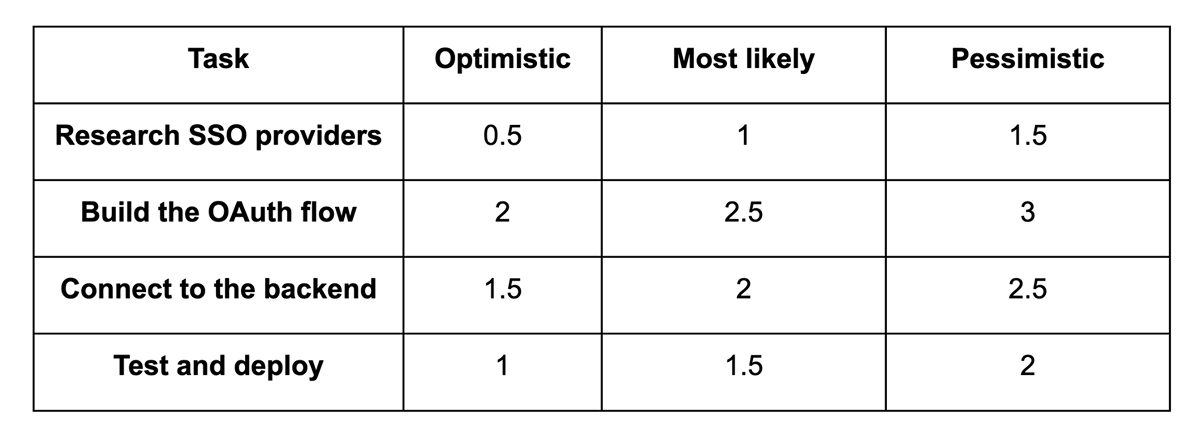Effort estimation is the process of predicting the amount of work required to complete a feature, task, or bug fix. It guides schedules, staffing, and priorities so everyone knows what is realistic. The result is usually expressed in hours, days, sprints, or person days. Estimations use structure, data, and experience to convert uncertainty into a range that the team can test and refine.
A good effort estimate allows teams to:
- Build realistic roadmaps and release schedules
- Allocate engineers where they add the most value
- Communicate with stakeholders in clear, concrete terms
- Spot risks and trade-offs before they become emergencies
- Avoid chronic overtime and last-minute panic
Consistent forecasting also creates a history of planned versus actual work. That history is a feedback loop that improves accuracy over time.
Basic Effort Estimation Techniques
Here are four commonly used software effort estimation methods in software engineering.
1. Expert Judgment
- A developer or tech lead creates an estimate based purely on personal experience with similar work.
- Great for small, familiar tasks because it is fast.
2. Analogous
- Find a recently completed ticket that resembles the new one (same tech stack, similar scope) and reuse its actual effort as the starting point.
- Works best when your backlog accurately records the time spent.
- Always verify that today’s context really matches yesterday’s.
3. Bottom-Up Estimation
- Break the feature into small subtasks, such as UI changes, API endpoints, tests, and documentation.
- Estimate each subtask, add them up, then include a small buffer for integration work.
- This approach takes longer but exposes hidden steps and is the most transparent for complex projects.
4. Three-Point Estimation
- For every task, capture three numbers:
- Optimistic
- Most likely
- Pessimistic
- Combine them with (O + 4M + P) / 6.
- The weighted average leans on the realistic middle while still accounting for surprises. Use the low and high ends to explain risk.
When to Choose Which
- Expert Judgment: tiny, routine work where discussion overhead would outweigh the benefit.
- Analogous: when you have a close historical match and trustworthy data.
- Bottom-Up: large or fuzzy projects that need a detailed map of tasks.
- Three-Point: high uncertainty or stakeholders who need a clear risk range.
Example
Imagine your team needs to add Single Sign-On (SSO) to an internal dashboard. Break the work into four clear subtasks:
- Research SSO providers
- Build the OAuth flow
- Connect to the backend
- Test and deploy
Then, estimate optimistic (O), most likely (M), and pessimistic (P) times for these.
Example ranges in days:

Apply the three-point formula to each task:
Estimate = (O + 4M + P) ÷ 6
= (5 + 4 * 7 + 9) ÷ 6
= 7
Tracking Estimates vs. Actuals
A forecast only becomes valuable when you compare it with the real time spent. After each task is completed, log the hours and note the difference from the original estimate. Aim to capture three quick fields:
- Planned effort: the number you predicted.
- Actual effort: the time the team reports.
- Reason for variance: scope change, unexpected bug, waiting on reviews, etc.
Review this at the end of every sprint to identify patterns. Then, discuss these findings during the retrospective and agree on changes, such as adding a 20% buffer for migrations or breaking large stories into smaller ones.
Tips for Better Estimation
- Use a range, not a single number. Saying 3–5 days makes it clear that some parts are still uncertain. A single 4-day claim appears exact, but it’s usually not the case.
- Write down your assumptions. Record things like reusable code, staffing levels, or tool limits. This lets reviewers see if those facts change later.
- Look at similar past work. Open old tickets or pull request times before relying on memory.
- Count the tasks that are not coding. Code reviews, tests, meetings, and deployments all take time. Include them in the plan so they don’t surprise you.
- Estimate as a group. A quick Planning Poker session helps teammates spot missing steps and keeps optimism in check.
Effort Estimation Software Tools
You can estimate with pen and paper, but simple tools keep numbers tidy and easy to share:
- Issue trackers (Jira, Linear, Trello) store the estimate next to each ticket and allow you to log the actual time later.
- Spreadsheets make it easy to add up bottom-up estimates or run the three-point formula.
- Dedicated estimation apps like Forecast.app automatically turn estimates into timelines and simple charts.
Conclusion
Good forecasting turns guesswork into a clear plan. It keeps schedules on track, reduces stress, and makes releases predictable. Try it on one upcoming ticket: pick a method, write down your assumptions, and see how it goes. Regular practice will sharpen your estimates and ensure the project runs more smoothly.
